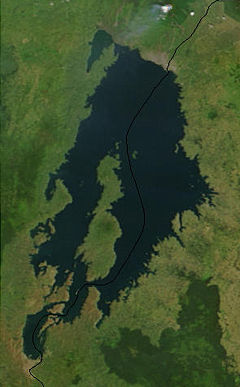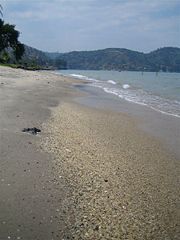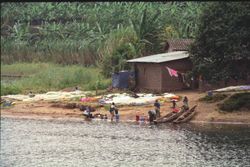Lake Kivu
2008/9 Schools Wikipedia Selection. Related subjects: African Geography
| Lake Kivu | |
|---|---|
|
|
|
| Coordinates | |
| Lake type | Rift Valley lakes, Meromictic |
| Primary outflows | Ruzizi River |
| Catchment area | 7,000 km² (2,700 sq mi) |
| Basin countries | Rwanda, Democratic Republic of Congo |
| Max. length | 89 km (55 mi) |
| Max. width | 48 km (30 mi) |
| Surface area | 2,700 km² (1,040 sq mi) |
| Average depth | 240 m (787 ft) |
| Max. depth | 480 m (1,575 ft) |
| Water volume | 500 km³ (120 cu mi) |
| Surface elevation | 1,460 m (4,790 ft) |
| Islands | Idjwi |
| Settlements | Goma, Congo Bukavu, Congo Kibuye, Rwanda Cyangugu, Rwanda |
Lake Kivu is one of the Great Lakes of Africa. It lies on the border between the Democratic Republic of the Congo and Rwanda, and is in the Albertine (western) Rift, a part of the Great Rift Valley. Lake Kivu empties into the Ruzizi River, which flows southwards into Lake Tanganyika.
Geography and fisheries
The lake covers a total surface area of some 2,700 km² (1,040 sq mi) and stands at a height of 1,460 metres (4,790 ft) above sea level. The lake bed sits upon a rift valley that is slowly being pulled apart, causing volcanic activity in the area, and making it particularly deep, its maximum depth of 480 m (1,575 ft) is ranked fifteenth in the world. The lake is surrounded by majestic mountains.
The world's tenth-largest inland island, Idjwi, lies in Lake Kivu, while settlements on its shore include Bukavu, Kabare, Kalehe, Sake and Goma in Congo and Gisenyi, Kibuye and Cyangugu in Rwanda.
Native fish include species of Barbus, Clarias, and Haplochromis, as well as Nile Tilapia. Limnothrissa miodon, one of two species known as the Tanganyika sardine, was introduced in 1959 and formed the basis of a new pelagic zone fishery. In the early 1990s, the number of fishers on the lake was 6,563, of which 3,027 were associated with the pelagic fishery and 3,536 with the traditional fishery. Widespread armed conflict in the surrounding region from the mid-1990s resulted in a decline in the fisheries harvest.
Chemistry
Lake Kivu is one of three known exploding lakes, along with Cameroonian Lake Nyos and Lake Monoun, that experience violent lake overturns. Analysis of Lake Kivu's geological history indicates a periodic massive biological extinction about every 1,000 years. The trigger for lake overturns in Lake Kivu's case is unknown but periodic volcanic activity is suspected. The gaseous chemical composition of exploding lakes is unique to each lake; in Lake Kivu's case, methane and carbon dioxide due to lake water interaction with a volcano. The risk from a possible Lake Kivu overturn would be catastrophic, dwarfing other documented lake overturns at Lakes Nyos and Monoun, since approximately 2 million people live in the lake basin.
Cores from the Bukavu Bay area of the lake, reveal the bottom has layered deposits of the "rare" mineral monohydrocalcite interlain with diatoms, on top of sapropelic sediments with high pyrite content. These are found at three different intervals. The sapropelic layers are believed to be related to hydrothermal discharge and the diatoms to a bloom which reduced the carbon dioxide levels low enough to precipitiate monohydrocalcite.
Scientists hypothesize that sufficient volcanic interaction with the lake's bottom water that has high gas concentrations would heat water, force the methane out of the water, spark a methane explosion, and trigger a nearly simultaneous release of carbon dioxide.The carbon dioxide would then suffocate large numbers of people in the lake basin as the gases roll off the lake surface. It is also possible that the lake could spawn lake tsunamis as gas explodes out of it.
The risk posed by Lake Kivu began to be understood during the analysis of more recent events at Lake Nyos. Lake Kivu's methane was only originally thought to be a cheap natural resource for export and the generation of cheap power. Once the mechanisms that caused lake overturns began to be understood, so did the risk the lake posed to the local population.
An experimental vent pipe was installed at Lake Nyos in 2001 to degas the deep water, but such a solution for the much larger Lake Kivu would be extremely expensive, running into millions of dollars. No plan has been initiated to reduce the risk posed by Lake Kivu.
Methane extraction
Lake Kivu has recently been found to contain approximately 55 billion cubic metres (72 billion cubic yards) of dissolved methane gas at a depth of 300 metres (1,000 ft). Until 2004, extraction of the gas was done on a small scale, with the extracted gas being used to run boilers at a brewery, the Bralirwa brewery in Gisenyi. As far as large-scale exploitation of this resource is concerned, the Rwandan government is in negotiations with a number of parties to produce methane from the lake. Extraction is said to be cost effective and simple because once the gas rich water is pumped up the dissolved gases (primarily carbon dioxide, hydrogen sulphide and methane) begin to bubble out as the water pressure gets lower. This project is expected to increase Rwanda's energy generation capability by as much as 20 times and will enable Rwanda to sell electricity to neighboring African countries.
Human history
The first European to visit the lake was German Count Adolf von Götzen in 1894. Since then it has been caught up in the conflict between Hutu and Tutsi people in Rwanda, and their allies in DR Congo, which led to the 1994 Rwandan Genocide and the First and Second Congo Wars. Lake Kivu gained notoriety as a place where many of the victims of the genocide were dumped.


